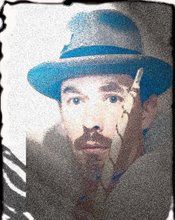
Woad (Isatus tinctoria/I. indigotica)
In his memoirs of the Gallic wars against the ‘brutish Western Pagans’ Julius Caesar draws a conclusive observation of the tribes he encountered in the south east of Britain in his principal invasion;
“Omnes vero se Britannii vitro infuciant.” (All the Britons die themselves with woad).
In addition to its historical use as a dye and a medium for tattooing, woad also has a long tradition as a herbal medicine. Also called Da Qing Ye in the Chinese pharmacopiea, it is a powerful antibacterial and antiviral; containing the essential compounds Indican and Isatin B. This makes it suitable and effective against most common bacterial infections, particularly those originating from staphylococci, pneumococci and meningococci. Another scientific study identified another antimicrobial substance in woad called tryptanthrin which is effective against dermatophytes, which are fungi that cause skin diseases such as ringworm. Woad may help with a variety of conditions such as influenza, meningitis, encephalitis, and common skin disorders such as warts, and athletes foot. As an anti-inflammatory it increases phagocytosis (the pathogen destroying capacity of white blood cells), thus aiding the elimination of infections.
The recommended dosage of the powdered herb is 2g, 4-6 times per day.
In the Judgement of Cormac Mac Airt, a historical Irish tale, Woad or glaisin plays a key role in the restoration of justice; When Cormac, the rightful heir to the throne of all Ireland was a boy, he lived in Tara in disguise; for the throne was held by the usurper Mac-Conn, so that Cormac dared not reveal himself. There was at that time a female ‘Brewy’ or peasant named Bennaid whose sheep trespassed on the Royal Domain and consequently ate up the Queen’s valuable crop of glaisin (woad-plants) which were used for dying cloth. The Queen instituted proceedings for damages, and the question came up before the King for a decision. The King, who after hearing the evidence decided that the sheep should be forfeit in payment for the loss of the glaisin. “Not so.” Exclaimed the stranger-boy Cormac, who was present. And who could not restrain his judicial instincts and inheritance. “The cropping of the sheep should be sufficient for the cropping of the glaisin; the wool for the woad, both will grow again.” “That is a true judgement.” Exclaimed all, “And he who has pronounced it is surely the Son of a King.”
More info on Woad body-art:
http://rds.yahoo.com/_ylt=A9G_Rq8Bx7ZEyv4ApBOjzbkF;_ylu=X3oDMTA4NDgyNWN0BHNlYwNwcm9m/SIG=12k0rhh4t/EXP=1152915585/**http:/www.hippy.com/albion/woad_and_modern_tribal_bodyart_i.htm
In his memoirs of the Gallic wars against the ‘brutish Western Pagans’ Julius Caesar draws a conclusive observation of the tribes he encountered in the south east of Britain in his principal invasion;
“Omnes vero se Britannii vitro infuciant.” (All the Britons die themselves with woad).
In addition to its historical use as a dye and a medium for tattooing, woad also has a long tradition as a herbal medicine. Also called Da Qing Ye in the Chinese pharmacopiea, it is a powerful antibacterial and antiviral; containing the essential compounds Indican and Isatin B. This makes it suitable and effective against most common bacterial infections, particularly those originating from staphylococci, pneumococci and meningococci. Another scientific study identified another antimicrobial substance in woad called tryptanthrin which is effective against dermatophytes, which are fungi that cause skin diseases such as ringworm. Woad may help with a variety of conditions such as influenza, meningitis, encephalitis, and common skin disorders such as warts, and athletes foot. As an anti-inflammatory it increases phagocytosis (the pathogen destroying capacity of white blood cells), thus aiding the elimination of infections.
The recommended dosage of the powdered herb is 2g, 4-6 times per day.
In the Judgement of Cormac Mac Airt, a historical Irish tale, Woad or glaisin plays a key role in the restoration of justice; When Cormac, the rightful heir to the throne of all Ireland was a boy, he lived in Tara in disguise; for the throne was held by the usurper Mac-Conn, so that Cormac dared not reveal himself. There was at that time a female ‘Brewy’ or peasant named Bennaid whose sheep trespassed on the Royal Domain and consequently ate up the Queen’s valuable crop of glaisin (woad-plants) which were used for dying cloth. The Queen instituted proceedings for damages, and the question came up before the King for a decision. The King, who after hearing the evidence decided that the sheep should be forfeit in payment for the loss of the glaisin. “Not so.” Exclaimed the stranger-boy Cormac, who was present. And who could not restrain his judicial instincts and inheritance. “The cropping of the sheep should be sufficient for the cropping of the glaisin; the wool for the woad, both will grow again.” “That is a true judgement.” Exclaimed all, “And he who has pronounced it is surely the Son of a King.”
More info on Woad body-art:
http://rds.yahoo.com/_ylt=A9G_Rq8Bx7ZEyv4ApBOjzbkF;_ylu=X3oDMTA4NDgyNWN0BHNlYwNwcm9m/SIG=12k0rhh4t/EXP=1152915585/**http:/www.hippy.com/albion/woad_and_modern_tribal_bodyart_i.htm



No comments:
Post a Comment